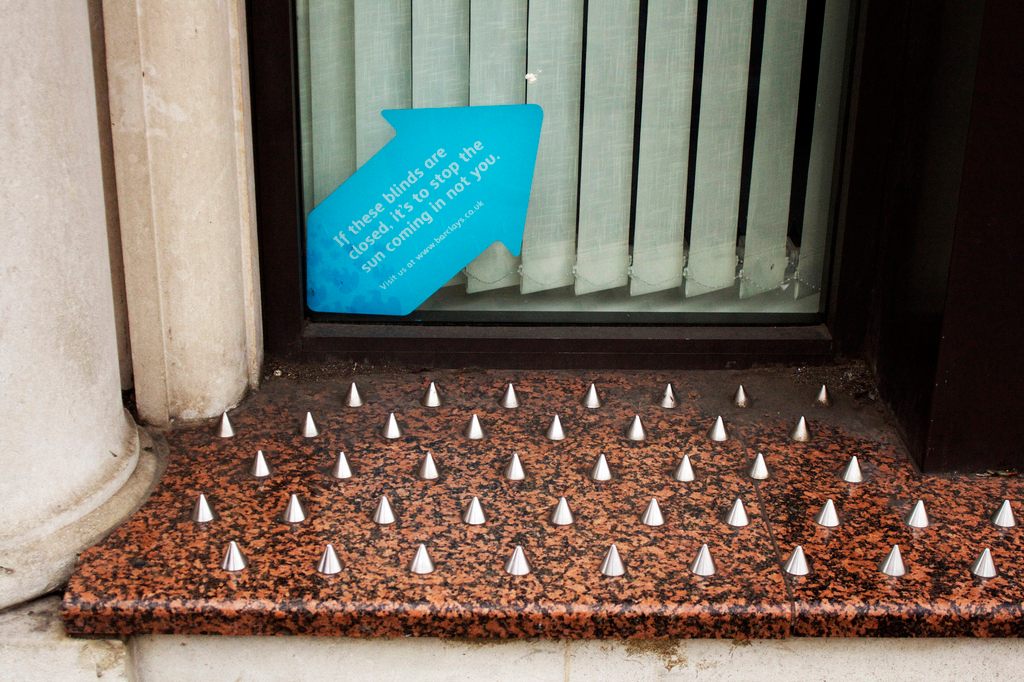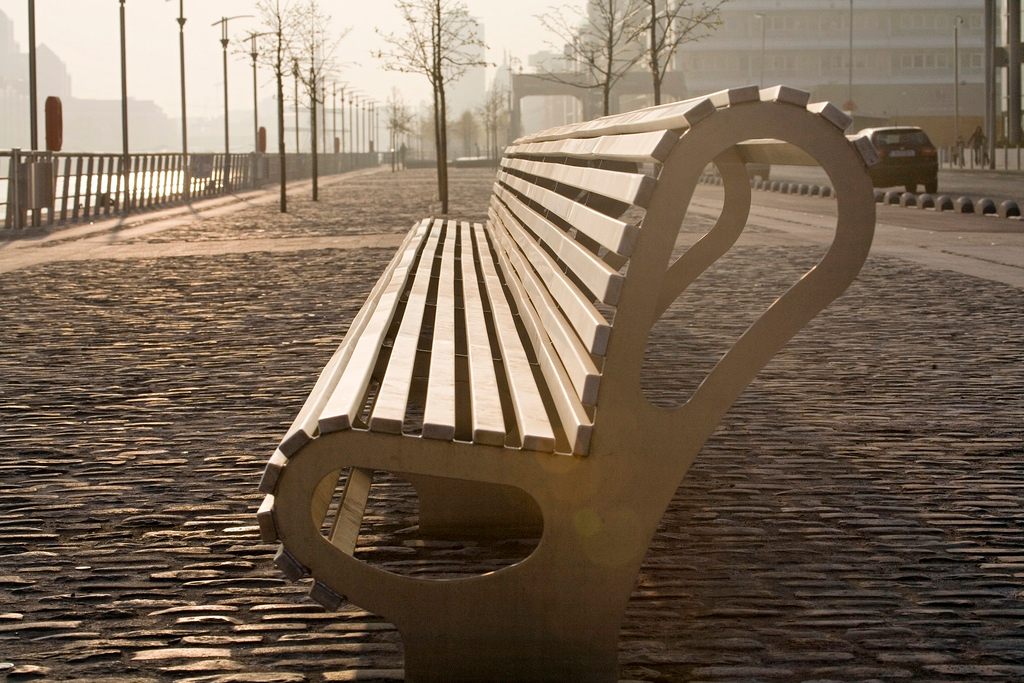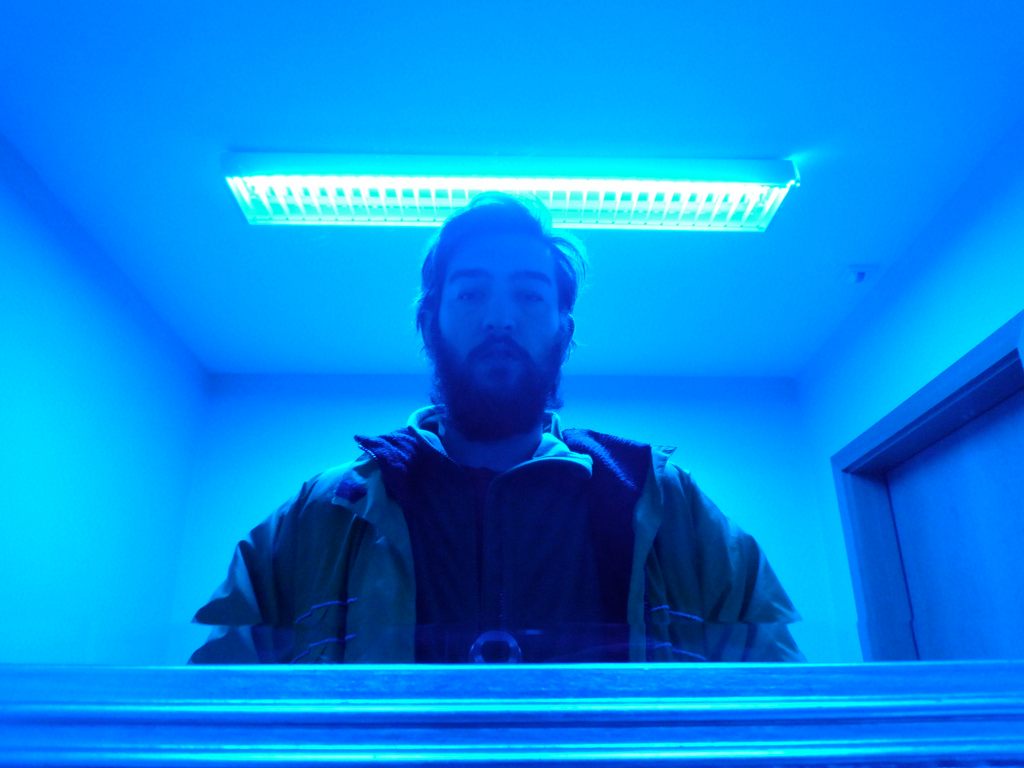The Subtle Design Features That Make Cities Feel More Hostile
Think your city doesn’t like you? You’re right.

None-too-subtle spikes at the 18th-century Miles Brewton House in Charleston, South Carolina. (Photo: Spencer Means/CC BY-SA 2.0)
There’s a fearsome fence surrounding the Miles Brewton House in Charleston, South Carolina. Its wrought-iron rails are topped with a cheval de frise, a horizontal bar covered in long spikes that jut out at multiple angles. Added in response to a planned slave revolt in 1822, the spiky bar sends a clear message: you are not welcome here.
Historically, landowners and city planners have kept sections of the population at bay by incorporating defensive design features into the architecture: spiked fences; barbed wire; a castle moat. In the 21st century, however, overt deterrents like these have given way to subtler features aimed at exerting social control, and keeping unwanted groups out.
In 2014, widespread outrage arose when a luxury London apartment building installed “anti-homeless spikes“ to prevent people from sleeping in an alcove near the front door. The spikes, which were removed following the public outcry, drew attention to a broader urban phenomenon known as hostile architecture.

Window spikes to prevent people resting on a ledge. (Photo: Jonny Hughes/CC BY 2.0)
“The term hostile architecture is new—or new in the popular vernacular anyway,” says James Petty, a freelance criminologist whose PhD research focuses on the ways in which society regulates homelessness. “But practices of designing cities and urban landscapes in certain ways that favor certain groups of people and not others has been going on for a long time.”
Hostile architecture, also known as defensive architecture, exists on a spectrum. At one end are the overt design features that are obvious to anyone walking by—like spikes and fences. At the other end, says Petty, are the design elements in which “the hostile function is often embedded under a socially palatable function.”
A prime example is street furniture, particularly public benches. Take a look at these four designs:

Street furniture in Manchester. (Photo: Denna Jones/CC BY 2.0)

A bench in Vienna. (Photo: Herzi Pinki/CC BY-SA 4.0)

Seating in the London borough of Camden. (Photo: The wub/CC BY-SA 4.0)

A shallow bench at the Dublin Docklands. (Photo: William Murphy/CC BY-SA 2.0)
All of them provide a place for tired citizens to rest their weary legs—and all of them have been designed to preclude homeless people from sleeping there by making it impossible or uncomfortable to lie down on the bench.
Hostile architecture can be incorporated into both public and private spaces. “Local governments might do it explicitly, but might also do it implicitly,” says Petty.
It’s the same story for privately owned land that is publicly accessible, such as shopping malls. “Often it’s done under the radar, so it’s not explicitly stated, it’s just like, ‘Oh, we want to upgrade this area.’ And then the things that are upgraded are all designed to stop homeless people lying on benches.”

Divided seating outside London’s Royal Courts of Justice. (Photo: Alan Stanton/Public domain)
Hostile design comes in even more innocuous, and sometimes even lovely forms. Take the humble potted plant. What could be hostile about a leafy ficus in a pretty pot? Nothing—until you consider where it’s placed. When set strategically in alcoves, “just as much as the spikes, it means that a homeless person can’t sleep there,” says Perry.
It can be a similar story with timed sprinklers. On the surface they’re just watering a garden or keeping the sidewalk clean, but they have also been used to disperse homeless people. Homeless people are the main group affected by hostile architecture, but skateboarders, loitering teenagers, and people who use drugs are also targeted in increasingly creative ways.
In 2009, the Nottingham Post in England reported that the local residents’ association had installed pink lights at underpasses to deter teenagers from congregating there. The lighting color was apparently chosen because, in addition to its purported calming effect—“seen as ‘uncool’ by some young males,” it highlights facial blemishes. (This is a more cosmetically focused version of the blue light seen in some public bathrooms, which is installed in an effort to curb intravenous drug use by making it difficult for people to see their veins.)

Blue light in a public bathroom. (Photo: Jason Eppink/CC BY 2.0)
But where is the line drawn between hostile architecture that seeks to favor one class of people over another, and practical urban planning that aims to keep all people safe? “All urban architecture or urban design has a level of control built into it,” says Petty, citing pedestrian crossings and sidewalks as features that guide the behavior of the public. “But then you’ve got a point where that kind of controlling becomes direct, explicit, and targeted against certain groups and not others.”
Art is one frontier where citizens are fighting back. Individual artists and collectives have been using art to raise awareness of hostile design. Sarah Ross’s “archisuits,” for example, are jogging outfits that incorporate substantial padding. The placement of the padding was designed specifically to fit around the hard dividers of Los Angeles benches, making it possible for the wearer to lie down comfortably.
But art is also an area in which hostile architecture can be perpetuated. Petty believes that street art and public sculpture will increasingly be incorporated into cities’ social control strategies. In other words, that huge eye-catching sculpture in the courtyard of a fancy office building may ostensibly be there for aesthetic reasons, but it’s also preventing the wrong kind of people from congregating in a space that’s not meant for them.




















Follow us on Twitter to get the latest on the world's hidden wonders.
Like us on Facebook to get the latest on the world's hidden wonders.
Follow us on Twitter Like us on Facebook